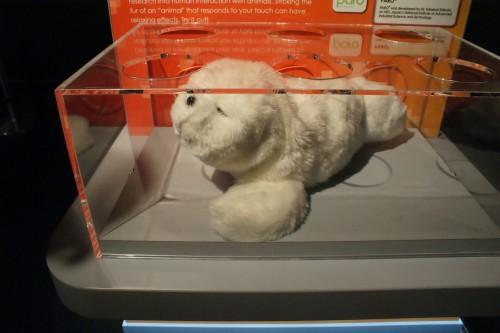
Decades ago, numerous horror and science fiction films were made confronting a very real fear people held — technophobia, or the fear of robots. Many people still fear robots, but shouldn’t, as the uses of robots and understanding of them has evolved, as shown in the Robots Revolution exhibit currently open at the Museum of Science and Industry.
This fear of robots is understandable, but should be simple to overcome after attending the exhibit, according to John Llewellyn, the Exhibit Developer at the Museum of Science and Industry.
“(Through this exhibit) we want people to have a critical conversation about robots in their lives,” Llewellyn said. “It’s a good discussion for people to have. There are whole fields of industries that have yet to be created to take advantage of the field of robotics.”
Although there have been exhibits featuring robots throughout the museum’s past, Llewellyn feels as if Robots Revolution is able to stand on its own.
“We’ve had a couple robot exhibits over the years and this is probably the most impressive one because the timing is right on it,” Llewellyn said. “There is more robot development going on now than there was before, so a lot of different things are converging with the technology. It made it a really good time to gather robots together.”
The exhibit opened May 21, and has already had thousands of visitors eager to see the robots on display.
The robots throughout the exhibit were divided into three categories based on their abilities; cooperation, locomotion and skills. Each section featured interactive activities enjoyable for children and adults alike, including r-one Swarm Robots, which show how robots can work together in groups to accomplish tasks in the cooperation section, and a wide variety of grippers, robots that can grip numerous objects, in the skills section.
The robots that were chosen to be showcased were hand-selected by the Museum of Science and Industry from a larger pool of robots.
“We started out with probably 100 different prospects and then we narrowed it down based on what was available and what were the most interesting robots,” Llewellyn said. “It’s a little bit of a hybrid of the robots that we originally wanted and what became available as time went on.”
Some of the robots in the exhibit are already being embraced by the masses, and are simple including the PARO created by Dr. Takanori Shibata of Japan’s National Institute of Advanced Industrial Science and Technology. PARO is a robotic seal that looks like any other stuffed animal, but has tactile sensors and responds to touch, making it helpful in places like nursing homes and hospitals because of its calming effects. Each PARO robot is programmed differently, so the robots get to know the way their owners pet them.
“It’s a very responsive robot,” Llewellyn said.
Others are more futuristic, but are already becoming part of our modern society, including Google’s self-driving car, an idea that’s being embraced by car companies.
“I see robotics becoming more ubiquitous in society,” Llewellyn said. “They’re going to be a little more woven into our everyday lives, kind of like how the smartphone burst on the scene seven or eight years ago, but now people can’t imagine life without them.”
One of the most fun features of the exhibit was Build-A-Bot, in which visitors can construct their own miniature robots, using different modules that each have a certain function. Each robot was different, as they are customized by their particular modules.
The exhibit also hosts a visible robot garage, where repairs are made to any damaged robots, which is another captivating sight for visitors, as kids line the whole area watching through the windows as one of the three robot specialists the museum has hired makes repairs.
Robots Revolution is especially great for children, as almost every robot has some sort of interactive aspect to it that is manageable for all ages.
The interactivity in the exhibit has highlighted another fear regarding robots — that there will one day be no more need for humans.
“Robots need people,” Llewellyn stressed, as visitors to the exhibit controlled the robots throughout all of the sections of the exhibit.
The exhibit runs through January 2016.

